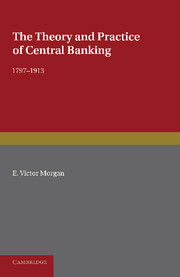Book contents
- Frontmatter
- Contents
- Tables
- Editorial Preface
- Author's Preface
- Chapter I Banks and Banking in the Early Nineteenth Century
- Chapter II The Bank Restriction Period, 1797–1821
- Chapter III Monetary Theory of the Bank Restriction Period
- Chapter IV The First Years of Resumption, the Crisis of 1825, and the Bank Charter Act, 1833
- Chapter V The Horsley Palmer Experiment, and the Bank Charter Act, 1844
- Chapter VI The Currency and Banking Controversy
- Chapter VII The Trial of the Bank Charter Act, 1844-58
- Chapter VIII The Great Boom, 1858-73
- Chapter IX The Great Depression, 1873-96
- Chapter X The Last Years of the Gold Standard, 1897–1913
- Chapter XI Monetary Theory of the Second Half of the Nineteenth Century
- Appendix Changes in Bank rate, 1876-1913, with the Amount of the Reserve of the Banking Department and the “Proportion” on the preceding Wednesday
- Index
Chapter XI - Monetary Theory of the Second Half of the Nineteenth Century
Published online by Cambridge University Press: 05 June 2016
- Frontmatter
- Contents
- Tables
- Editorial Preface
- Author's Preface
- Chapter I Banks and Banking in the Early Nineteenth Century
- Chapter II The Bank Restriction Period, 1797–1821
- Chapter III Monetary Theory of the Bank Restriction Period
- Chapter IV The First Years of Resumption, the Crisis of 1825, and the Bank Charter Act, 1833
- Chapter V The Horsley Palmer Experiment, and the Bank Charter Act, 1844
- Chapter VI The Currency and Banking Controversy
- Chapter VII The Trial of the Bank Charter Act, 1844-58
- Chapter VIII The Great Boom, 1858-73
- Chapter IX The Great Depression, 1873-96
- Chapter X The Last Years of the Gold Standard, 1897–1913
- Chapter XI Monetary Theory of the Second Half of the Nineteenth Century
- Appendix Changes in Bank rate, 1876-1913, with the Amount of the Reserve of the Banking Department and the “Proportion” on the preceding Wednesday
- Index
Summary
After 1844 monetary theory comes to have progressively less connection with the practical problems of central banking. The major practical issues of the first half of the century had concerned the working, first of an inconvertible, and then of a convertible note issue, in both of which the central bank was immediately and directly concerned. But in the second half of the century the things most in the public eye were the secular movements in prices closely associated in time with changes in the output of gold. It is the connection between the two which forms the most important point of discussion in monetary theory, and which was responsible for the development of such new ideas as there were. By the letter and the spirit of the act of 1844 the Bank was made only the passive agent in transmitting the effects of changes in the supply of gold to the economic system as a whole, and the theorists were quite right in paying little attention to its activities in this respect. The problems of the Bank were of a more technical nature— the size of the reserve, the behaviour of the bankers' balances, and so on —and they received comparatively little theoretical discussion. The ideas involved in the gold controversy, though only indirectly relevant, will take up a good deal of our space, but first we must clear away the legacy of dispute left by the Bank Charter Act itself.
THE POST BANK CHARTER ACT DISCUSSION
The surprising thing about the Bank Charter Act is its persistence. Within a generation of its passage it had been three times suspended by the arbitrary action of ministers; it was ridiculed by leading bankers, and condemned by eminent theorists; yet only once was a bill introduced into Parliament to make any serious modification of it. This one bill, introduced by Lowe in 1873, proposed a legal means by which the fiduciary issue could be exceeded so long as Bank rate was 12%; it was felt that this was too high a rate, and that the machinery proposed by the bill was too complicated, and it failed to find any support. Perhaps the reason for this inertia was that the public had been so wearied by the constant repetition of the arguments of the Currency and Banking controversy.
- Type
- Chapter
- Information
- The Theory and Practice of Central Banking, 1797–1913 , pp. 228 - 244Publisher: Cambridge University PressPrint publication year: 2013



